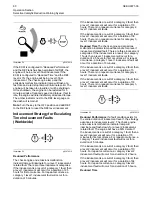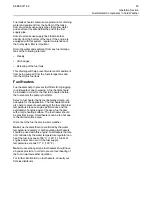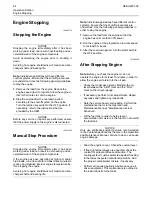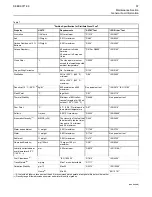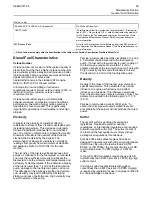
(Table 7, contd)
(3)
Ultra Low Sulfur Diesel Fuel with sulphur content less than 0.0015 percent 15 PPM (mg/kg) must be used. Use of diesel fuel with higher than
15 PPM sulphur limit in these engines will harm or permanently damage emissions control systems. Also, use of diesel fuel with higher than
15 PPM sulphur limit can shorten service interval.
(4)
The values of the fuel viscosity are the values as the fuel is delivered to the fuel injection pumps. Fuel should also meet the minimum viscos-
ity requirement and the fuel should meet the maximum viscosity requirements at 40 °C (104 °F) of either the “ASTM D445” test method or
the “ISO 3104” test method. If a fuel with a low viscosity is used, cooling of the fuel may be required to maintain “1.4 cSt”or greater viscosity
at the fuel injection pump. Fuels with a high viscosity might require fuel heaters to lower the viscosity to “1.4 cSt” at the fuel injection pump.
(5)
Follow the test conditions and procedures for gasoline (motor).
(6)
The lubricity of a fuel is a concern with low sulfur and ultra low sulfur fuel. Fuel with higher wear scar diameter than 0.52 mm (0.0205 inch)
will lead to reduced service life and premature failure of the fuel system. Refer to the lubricity section of this “Operation and Maintenance
Manual” Fluid Recommendations for more information.
(7)
Recommended cleanliness level for fuel as dispensed into machine or engine fuel tank is“ISO 18/16/13”or cleaner as per “ISO 4406”. Refer
to the “Contamination Control Recommendations for Fuels.
(8)
Examples of trace metals include but not limited to Cu, Fe, Mn, Na, P, Pb, Si, and Zn. Use of metal-based additives is not allowed.
(9)
Additional limit for fuel containing FAME. Fuel containing more than 2% v/v FAME must meet both tests.
Note:
The owner and the operator of the engine has
the responsibility of using the fuel that is prescribed
by the EPA and other appropriate regulatory
agencies.
NOTICE
Operating with fuels that do not meet the Perkins rec-
ommendations can cause the following effects: Start-
ing difficulty, reduced fuel filter service life, poor
combustion, deposits in the fuel injectors, signifi-
cantly reduce service life of the fuel system. Also, the
creation of deposits in the combustion chamber and
reduced service life of the engine.
NOTICE
The Perkins 2000 series of diesel engine must be op-
erated using Ultra Low Sulfur Diesel. The sulphur
content of this fuel must be lower than 15 PPM. This
fuel complies with the emissions regulations that are
prescribed by the Environmental Protection Agency
of the United States.
European ULSD 0.0010 percent (≤10ppm (mg/kg))
sulfur fuel is required by regulation for use in engines
certified to European nonroad Stage V type-approved
nonroad engines. Additionally, the Cetane number
should be less than 45, and the bio-diesel content
should be greater than 20% volume/volume.
Illustration 60
g02157153
Illustration 60 is a representation of the label that will
be installed next to the fuel filler cap on the fuel tank
of the application.
The fuel specifications that are listed in the table 8
are released as acceptable to use on all 2000 series
of engine.
Table 8
Acceptable Fuel Specification for the 2000 Series of Engines
Fuel Specification
Comments
EN590
European Automotive Diesel Fuel (DERV)
“ASTM D975 GRADE 1D S15”
“North American Light Distillate Diesel fuel with less than 15 PPM sul-
fur level”
“ASTM D975 GRADE 2D S15”
“North American Middle Distillate general-purpose Diesel fuel with less
than 15 PPM sulfur level”
“JIS K2204”
“Japanese Diesel Fuel” Must meet the requirements that are stated in
the lubricity section of this “Operation and Maintenance Manual” Fluid
Recommendations.
(continued)
68
SEBU9071-06







